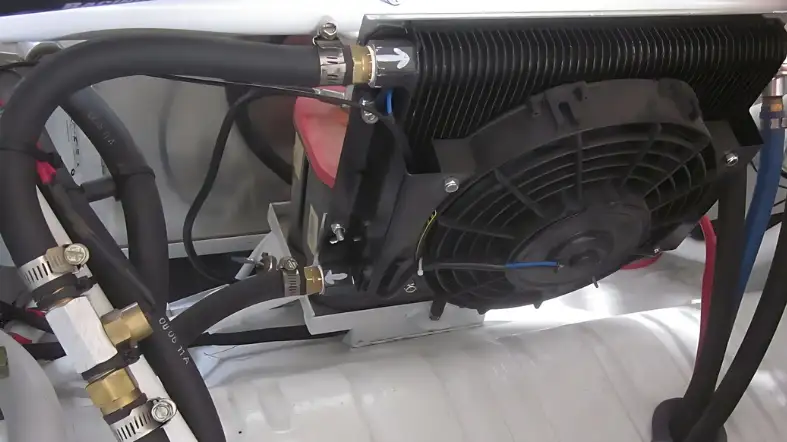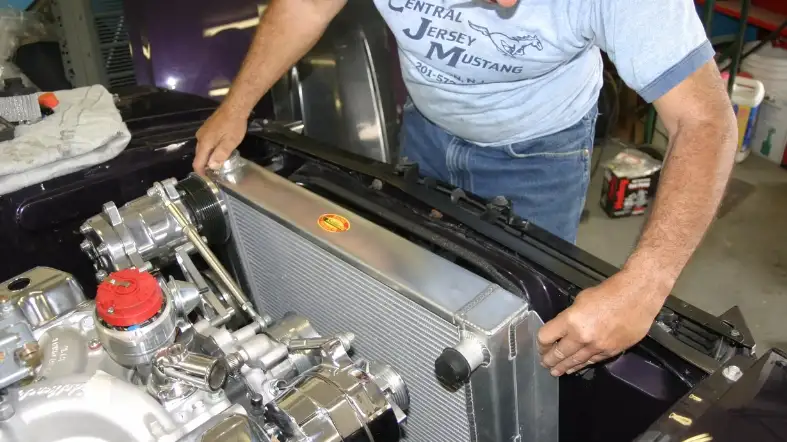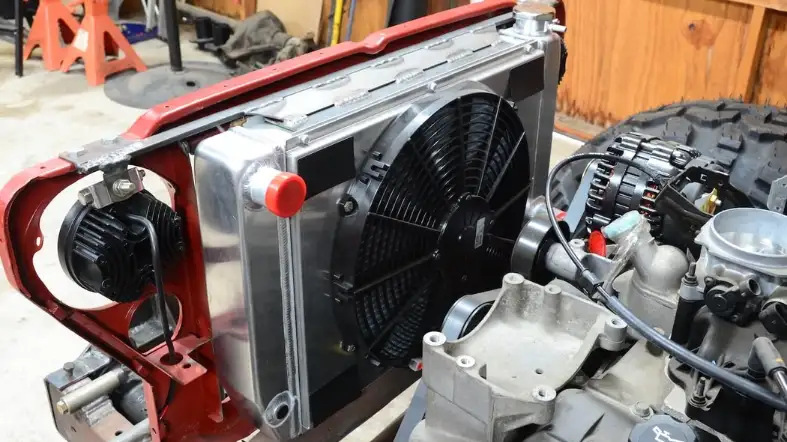If you’re a car enthusiast or simply someone who wants to understand more about engine temperature regulation, you’ve come to the right place.
You might be thinking, “Why should I care about the fan and the thermostat?
Well, understanding how these components work together can save you from potential engine overheating disasters and help you achieve better performance and fuel efficiency.
In this blog, we’ll explore the science behind thermostats and their relationship with cooling fans.

What temp should fan come on with 180 thermostat?
The fan should come on at around 200 degrees Fahrenheit (93 degrees Celsius) when using a 180-degree thermostat.
How the thermostat controls the flow of coolant in the engine?
In simple terms, a thermostat is a device that helps regulate the engine’s operating temperature by controlling the flow of coolant through the cooling system. Here’s a breakdown of how it works:
1. Temperature Sensing:
The thermostat contains a temperature-sensitive valve or element, usually made of wax or a similar material. This element is designed to respond to changes in temperature.
2. Valve Position:
When the engine is cold, the thermostat remains closed to restrict the flow of coolant. This forces the coolant to circulate within the engine, allowing it to warm up quickly.
3. Opening Temperature:
Each thermostat has a specific opening temperature, which is typically between 180 to 195 degrees Fahrenheit (82 to 90 degrees Celsius).
Once the engine reaches this temperature, the thermostat begins to open.
4. Coolant Flow:
As the thermostat opens, it allows coolant to flow from the engine into the radiator. This enables the heated coolant to dissipate its heat to the surrounding air.
5. Optimal Temperature:
The thermostat continuously adjusts the position of its valve to maintain the engine at an optimal operating temperature.
It achieves this by balancing the rate of coolant flow through the radiator with the rate at which heat is generated by the engine.
6. Cooling Efficiency:
If the engine temperature starts to rise above the optimal range, the thermostat opens wider to increase the flow of coolant through the radiator, which enhances the cooling efficiency.
7. Heat Conservation:
On the other hand, if the engine temperature drops below the desired range, the thermostat partially or fully closes the valve to reduce the flow of coolant to the radiator. This allows the engine to retain more heat and warm up faster.
8. Engine Warm-up:
During cold starts, the closed thermostat helps the engine warm up quickly by preventing excessive cooling.
This is important because engines operate most efficiently and produce less wear when they reach their optimal operating temperature.
9. Fail-Safe Mode:
In case the thermostat fails to function correctly, many modern vehicles have a fail-safe mode.
In this mode, the thermostat remains open, allowing coolant to flow freely and prevent overheating.
This ensures that the engine can continue to operate, albeit at a slightly reduced efficiency.
The Importance of Choosing the Right Temperature

When using a 180-degree thermostat, it’s essential to choose the correct temperature setting for the electric fan to come on.
Here are some points that illustrate the importance of selecting the right temperature for the fan:
1. Prevents overheating:
One of the most critical reasons to choose the right temperature for the fan is to prevent engine overheating.
The fan’s purpose is to help regulate the engine’s temperature and prevent it from getting too hot.
If the fan doesn’t come on at the right temperature, it could lead to engine damage and expensive repairs.
2. Optimizes performance:
Selecting the proper temperature setting for the fan can also help optimize the engine’s performance.
When the engine runs at the optimal temperature, it can run more efficiently and produce more power.
3. Saves fuel:
An overheating engine can waste fuel and reduce efficiency. By choosing the right temperature for the fan, you can prevent overheating and save fuel.
4. Extends engine life:
Overheating can damage the engine and reduce its lifespan. By keeping the engine at the optimal temperature, you can extend its life and prevent costly repairs.
5. Reduces noise:
When the fan comes on at the right temperature, it can operate quietly and efficiently.
In contrast, a fan that runs constantly or doesn’t come on at the right temperature can be noisy and disruptive.
What are the Signs of Improper Fan Activation?
Improper fan activation can be a cause for concern as it may indicate an issue with the cooling system of a vehicle.
If you have a fan that is coming on with a 180-degree thermostat, here are some signs you might notice:
1. Frequent or Continuous Fan Operation:
If the fan turns on and remains on for extended periods, even when the engine is not excessively hot, it could indicate a problem.
The fan should typically activate only when the engine reaches a certain temperature threshold.
2. Delayed Fan Activation:
Conversely, if the fan takes a long time to come on or doesn’t activate at all when the engine gets hot, it may be a sign of improper fan activation.
This can lead to overheating, especially in traffic or during low-speed driving.
3. Inconsistent Fan Operation:
If the fan turns on and off sporadically without a clear pattern, it suggests that the fan control system is not functioning correctly.
The fan should operate consistently when needed to regulate the engine temperature.
4. Engine Overheating:
One of the most evident signs of improper fan activation is engine overheating.
If the fan fails to turn on when the engine gets too hot, it can result in the coolant not being adequately cooled, leading to high engine temperatures and potential damage.
5. Reduced Performance:
Improper fan activation can also cause a drop in engine performance.
As the engine temperature rises beyond optimal levels, it can negatively impact the combustion process, leading to decreased power output and overall engine efficiency.
6. Coolant Leaks:
If the fan is continuously running or not activating when necessary, it could cause excess pressure in the cooling system.
This pressure can lead to coolant leaks, which may manifest as puddles or stains beneath the vehicle.
7. Unusual Fan Noise:
A malfunctioning fan control system may produce strange or excessive noise when the fan operates.
This can range from grinding or rubbing sounds to loud, high-pitched whirring. Unusual fan noise should be investigated promptly to prevent potential damage.
What happens if the fan doesn’t come on with a 180 thermostat?

When the fan fails to come on with a 180 thermostat, it can have several implications for the cooling system of a vehicle.
Here are some detailed points explaining the potential consequences:
1. Inadequate Cooling:
The primary function of the fan is to help dissipate heat from the engine and radiator.
If the fan doesn’t engage, especially during situations where the engine temperature rises above normal levels, it can lead to inadequate cooling.
This can result in overheating, which is detrimental to the engine’s health.
2. Increased Risk of Engine Damage:
Overheating puts excessive strain on various engine components. Continuous overheating can cause the cylinder head to warp, leading to a blown head gasket or even engine failure.
Additionally, the pistons, rings, and valves may experience accelerated wear or damage due to excessive heat, compromising their efficiency and potentially leading to costly repairs.
3. Impaired Performance:
When the engine overheats, it can affect overall vehicle performance. The engine might lose power, leading to reduced acceleration and diminished fuel efficiency.
In extreme cases, the engine might shut down entirely, leaving you stranded and requiring immediate attention.
4. Transmission Troubles:
Some vehicles have cooling systems that are interconnected with the transmission system.
If the engine overheats due to a malfunctioning fan, the excessive heat can also affect the transmission fluid.
Overheated transmission fluid loses its ability to lubricate and cool the transmission properly, potentially causing transmission failure or expensive repairs.
5. Potential Damage to Other Components:
Prolonged overheating can harm other components within the engine compartment.
For example, plastic components, such as hoses, gaskets, and electrical connectors, may degrade or melt under high temperatures.
This can lead to coolant leaks, vacuum leaks, or electrical malfunctions, further complicating the repair process.
6. Increased Fuel Consumption:
Inefficiencies caused by engine overheating can lead to increased fuel consumption.
When the engine operates at higher temperatures, it becomes less efficient in converting fuel into mechanical energy, resulting in lower fuel economy.
This can lead to more frequent visits to the gas station and additional expenses in the long run.
7. Environmental Impact:
An overheating engine can release excessive emissions, contributing to air pollution.
Additionally, coolant leaks caused by overheating can contaminate soil and water sources, posing environmental hazards.
FAQs
Q. At What Temperature Should The Cooling Fan Start Running?
A: The cooling fan should generally start running when the engine’s coolant temperature reaches around 200 degrees Fahrenheit.
However, it’s important to note that this can vary depending on the specific vehicle and its cooling system.
Q. Why Does The Fan Need To Come On?
A: The primary purpose of the cooling fan is to prevent the engine from overheating.
When the coolant temperature rises, the fan activates to cool down the radiator and dissipate heat, helping to maintain the engine’s optimal operating temperature.
q. Will The Fan Always Run When The Temperature Exceeds 200 Degrees Fahrenheit?
A: Not necessarily. Some vehicles utilize a two-speed fan or variable-speed fan control system that adjusts the fan speed based on the cooling needs.
In such cases, the fan may operate at a lower speed for moderate temperature increases and ramp up to a higher speed for more significant heat buildup.
Q. Is It Normal For The Fan To Run Even After Shutting Off The Engine?
A: Yes, it is quite common for the fan to continue running for a short period after turning off the engine.
This is because the residual heat from the engine and radiator can still raise the coolant temperature.
Q. Can I Manually Override The Fan’s Operation?
A: It depends on the vehicle and its cooling system design.
Some cars may have a manual switch or control that allows you to turn on the fan manually, while others rely solely on automatic controls.
Refer to your vehicle’s manual or consult with a professional mechanic to determine if manual fan control is possible.
q. What If My Engine Temperature Consistently Exceeds The Normal Range?
A: If you notice that your engine consistently runs hotter than expected or frequently exceeds the recommended temperature range, it could indicate a problem with the cooling system.
It’s advisable to have your vehicle inspected by a qualified mechanic to diagnose and address any underlying issues.
Conclusion
When it comes to determining the optimal temperature at which the fan should come on with a 180-degree thermostat, it’s important to strike a balance.
While the thermostat itself opens at 180 degrees Fahrenheit, the fan shouldn’t kick in immediately at this temperature.
Instead, it’s advisable to have the fan turn on at around 10 to 15 degrees above the thermostat’s opening temperature.
This allows the engine to reach its operating temperature and ensures that the fan activates when it’s genuinely needed to cool things down.
Remember, the goal is to strike a balance between keeping the engine at an optimal operating temperature and preventing it from overheating.
